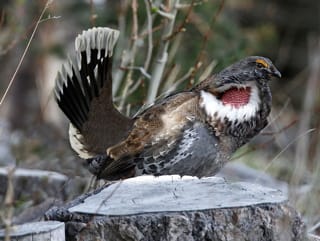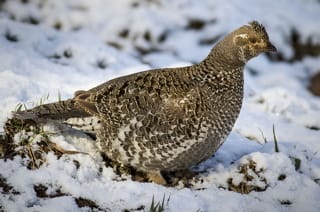Initially this guide displays common birds of all types that are flying right now in our area. Use the selectors below to view rare birds, view birds flying any time, restrict the output to a certain shape of bird, or search by name.
New Mexico is on the western edge of the Central Flyway which is one of the major migration pathways between north and south for birds traveling between breeding and wintering grounds along the Rocky Mountains. This has resulted in the state having an incredible diversity of birds with over 550 different species reported. A little more than half of this number are sighted annually on the Pajarito Plateau. Some of these birds are full-time residents, some migrate here for a few weeks or months, and other are only seen briefly as they pass through the region.
This guide features many of the birds known to frequent Los Alamos county by when they are likely to be seen in the area. You can get additional information on local birds by joining PEEC Birders or going to the eBird website. eBird also includes lists of rare bird sightings and birding hot spots.
Bird References
Birdweb
Cornell Lab of Ornithology
eBird
eNature
Institute for Bird Populations
National Audubon Society
New Mexico Ornithology Society
What Bird
xeno-canto
Subject Area Experts (all guides)
Steve Cary (butterflies)
Beth Cortright (insects)
Terry Foxx (invasive plants)
Leslie Hansen (mammals)
Richard Hansen (fish, mammals)
Dorothy Hoard (butterflies, trees)
Chick Keller (flowers, herbarium)
Shari Kelley (geology)
Kirt Kempter (geology)
Garth Tietjen (reptiles)
David Yeamans (birds)
Web Development and Content Management
Pat Bacha
Jennifer Macke
Graham Mark
Akkana Peck
Contact
Please contact us for local nature questions and sightings. We welcome comments, corrections, and additions to our guides.
For more information about local nature, please visit our Nature Blog or subscribe to PEEC This Week.
Make Selection
 Photo: male, displaying by Hari Viswanathan  Photo: male, not displaying by Hari Viswanathan  Photo: female by Mouser Williams |  Dusky GrouseDUGR (Dendragapus obscurus)Family: Phasianidae (Grouse, Quail, and Allies) Size: 15.5 - 21 in (39 - 53 cm) Flies: Mar 01 - Aug 21 Morphology: males are dusky gray with black tail tipped with gray, bare skin on the side of the neck colored red, and a yellow eyebrow; females are brownish gray with barred upper parts; immature are similar to females but with streaked back Status: native; locally common Food source: conifer needles, particularly in winter; leaves, flowers, buds, berries and insects in summer; young mostly eat insects Habitat: montane forests, slashes, subalpine clearings Typical location: Pajarito Mountain Dusky Grouse are shy, slow-moving, and well camouflaged birds. These birds generally feed on the ground in summer and forage in trees in winter. Dusky Grouse are most often noticed during breeding season. Males strut around with tails raised and red neck patches revealed making a series of deep hoots to attract females. After mating, females go off on their own to built a nest on the ground, usually under some cover. Young usually leave the nest within a day of hatching and follow the female around to find their own food. They start to fly when a little over a week of age. Tracks Info Photos Distribution Frequency |
